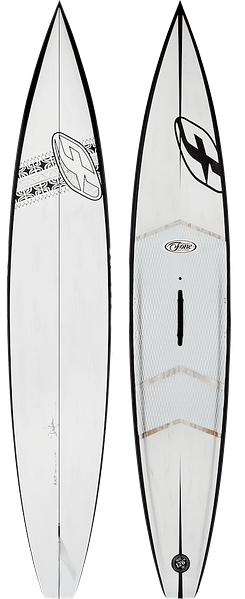In a previous article we discussed how using a SUP stroke meter can help you gauge your SUP power output and even compare equipment performance when testing paddles and stand up paddle boards. Expert paddlers such as Larry Cain advise that the fastest board for you might be different than the fastest board for a pro rider such as Connor Baxter. Just because a board is narrower than theoretically faster, it does not mean that it will be the fastest board for you because it might be too tippy or inappropriate for your weight. The bottom line when shopping for an SUP race board is that you need to test the board yourself in conditions similar to where you will be racing and training.One of our readers, Anthony Galang, took this advice and decided to objectively test a bunch of SUP race boards to see which board was fastest for him. In our opinion, Anthony might just have devised the method you should use to more objectively shop for your next SUP race board.
To perform this test you are going to need the following equipment:
- A metronome smartphone app
- A waterproof housing for your phone (duh)
- A waterproof set of headphones so you can hear the metronome
- A GPS device that will allow you to record laps/split
The way this test works is that you will be performing head to head efforts on multiple boards and eliminating boards as you go. The testing is time consuming and intensive but it is a great way to know which board is right for you. The trick to obtaining a good data set during testing is to try to make sure you do the same level of effort on each board throughout the testing. You will be measuring the speed of your board during the testing to see which board is fastest for you.
To keep your effort constant during testing you will paddle at a set cadence as dictated by your metronome and at a set level of exertion as dictated by your heart rate.
To perform a side by side comparison during the testing of your SUP race boards:
- Ride Board A in one direction for a fixed amount of time at a cadence dictated by your metronome (Anthony chose 47 SPM for testing).
- Start your Garmin lap when your heart rate is at your low Zone 3 heart rate and stay within 3-4 beats for the test. For Anthony this was between 141 and 145 BPM)
- Perform a 4-8 minute interval. When the interval is finished, start a rest lap on your Garmin and turn around
- Start another 4-8 minute interval when your heart rate is back to the heart rate when you started the test. Again, keep your cadence steady as dictated by the metronome app.
- When you get back to your starting point change to Board B, and repeated the test.
- Eliminate the slower board.
You will now have data on 2 efforts for each board (board A out and back, board B out and back). If you have more boards you want to test, you are going to repeat this test for each board. Before you run out and compare 12 boards you need to remember that you are not a machine and you are going to get tired over the course of the testing and this will skew your data (e.g. if you are not putting out as much power at a given heart rate because you are tired your data will not be accurate).
If you are testing a large number of SUP race boards, you should consider spreading your testing out over several days. Because you will be testing boards head to head on each day (e.g. you are going to test two boards and eliminate one) it is OK if the conditions are slightly different on different days (1) You should also remember that you should be using the same fin and paddle when testing each board.
When you download and analyze your data you are going to look for patterns and retest boards based on your analysis.
- If one board is faster than another board in both laps it is likely that it is a faster board.
- Conversely if one board is faster than another board on one lap but slower than the same board on another lap, this is an equivocal result and this test must be repeated to determine if the variable result is a because of testing effort or because the boards are equally matched. You will need to keep testing until one board wins both laps or you decide that there is no significant difference between the boards.
You can download Anthony’s testing spreadsheet at this link. NOTE: we anonymized the boards because we want the focus of this article to be on the testing process and not which boards won or lost in Anthony’s testing. That said, the F One Race Pro was the fastest board in Anthony’s testing.http://en.f-onesup.com/#/Fone-Products/_RACE/Produit/_RACE-PRO-12-6-28-.htm and that is the board he will be racing on next year.
(1) Technical note: there is one caveat to this recommendations. Some boards to better in flat-water. Some do better in the bump. No board is ideal for every condition. Testing boards in different conditions introduces some degree of “slop” into your data set.
Below is a pic of the Race Pro discussed above:

